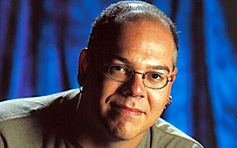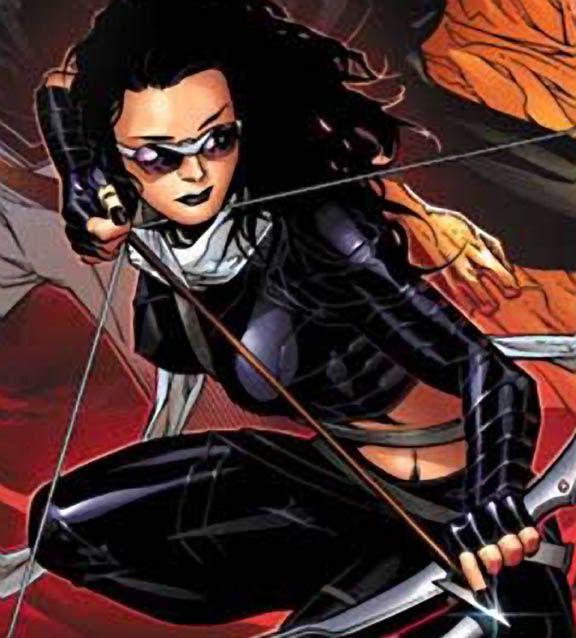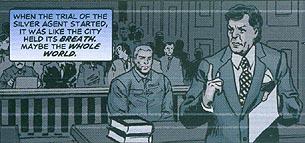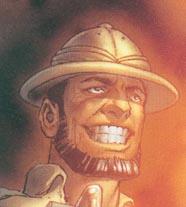JSA #56 by Geoff Johns & Don Kramer
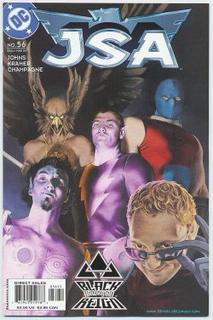
Now that we're halfway through the eight-month series of "Infinite Crisis" crossovers in
JSA, it seems as good a time as any to look back on one of the biggest lasting events in recent JSA history: Black Adam's conquest of Kahndaq.
In my next post, I'll be taking a look at the trial of Atom Smasher in #76. This post deals mostly with the events of "Black Reign" that set the stage for that trial. And due to the nature of the subject, I must admit upfront that my comments here will be a lot more subjective than is typical for this blog. There's plenty of opinion and politics involved. But it's something I feel strongly about, and it's important background for Atom Smasher's tory.
Kahndaq is yet another of DC's fictional nations, a Middle Eastern nation situated (according to #56) along the northern coast of the Sinai Peninsula:

Strangely, a map of the country seen in #57 doesn't show a coastline, but rather appears to display a landlocked nation. Go figure.
Kahndaq is also the homeland of Captain Marvel's rival, Black Adam. The country was burned to the ground by Vandal Savage around 1600 B.C., and Adam's wife and children were killed in the process. (The capital city of Kahndaq, Shiruta, is named for Adam's late wife.) In the current day, Kahndaq was ruled by a Saddam Hussein-esque dictator named Asim Muhunnad.
Adam assembled a team of JSA associates to assist him in overthrowing Muhunnad. They fought and killed a great many of Muhunnad's men, and when they finally confronted the dictator himself in his palace, Black Adam asked Atom Smasher to kill him. Atom Smasher complied, and carried out the order with a single resounding stomp.
The JSA talks a lot about how much they disapprove of the actions of Adam and their other former allies, but there's the occasional reference that they are not alone. From #57: "Many foreign powers are already denouncing the invasion of Kahndaq. None acting on its yet." Given that Atom Smasher was later put on trial for his participation, it would seem that someone in government seriously disapproved.
As for myself, though, I can't bring myself to see anything that would merit international outrage. Now if Adam had been a supervillain taking over a country for his own personal gain (like, say, Magneto invading Australia), I'd see plenty of room to be nervous.
But the important difference I see here is that Black Adam is himself a Kahndaqi. He was born in Kahndaq and he and his wife and children lived in Kahndaq. He still considers himself a citizen of Kahndaq after 3500 years. And I don't see a Kahndaqi overthrowing a Kahndaqi government to be an outside invasion. Rather, I consider it to be a
coup.
And the thing about coups is that they happen
all the time, and the world typically doesn't bat an eye. A power-hungry dictator overthrowing an elected government is probably going to attract some negative responses and resolutions, but I'm not sure when the last time was that the international community actually got personally involved following a coup.
Yet here it seems like the U.S. and the rest of the world is chomping at the bit to condemn Black Adam. There's nothing presented to suggest that Muhunnad was anything but a total monster. And there's also every indication that the Kahndaqi people welcomed Adam as a liberator and praised him for saving them Muhunnad and his men. There's a reference to there being a small number of supporters of the former dicatator, but the overwhelming evidence is that the people of Kahndaq love Black Adam.
So if everyone's happy, why are other nations (including the U.S.) so anxious to condemn what is arguably an internal Kahndaqi matter? Is it because of Adam's history with villainy, and in spite of his Justice Society tenure? Is it because instead of an army of regular men, he fought with a handful of costumed metahumans? Is it because the rest of his team was from places other than Kahndaq? (Only two, incidentally, were American-born.)
Were international laws broken, as the JSA would seem to suggest? It's hard to say. International law is a very murky thing, and is rarely binding on anyone. If Adam and his team were acting on behalf of a state, then it could be an illegal act of aggression, but there is no external state. Most of the team are free agents, and Adam is a Kahndaqi fighting for control of Kahndaq. Although there may be some treaty that could be applied, it's hard to imagine the international community wanting to get involved. Killing Muhunnad might have crossed a line, but we hear these international condemnations before anyone outside Kahndaq knew that had happened.
Still, as I said above, this can all be fairly subjective, and there could be extenuating DCU circumstances that would get states this riled. And that brings me to a little editorial complaint I have.
I thought Johns did a good job in "Black Reign" of presenting both sides of the case for Adam's actions. I find myself largely sympathizing with what Adam did, but I also see the JSA's point that he may have gone too far in some places (such as Brainwave's mental manipulations). However, while both arguments are there, the way the story and its follow-up, "Black Vengeance," are structured, and the way all the characters other than Adam react, they all support the argument that Adam was wrong. Hawkman even goes so far as to make Atom Smasher doubt his own sanity by making him hear voices (courtesy of the Atom) that attempt to induce guilt. The story makes Adam unusually hostile in order to set off three issues of fighting, and at the end of the second arc in #75, he's left looking something of a chump. He saves Atom Smasher's life, and then the JSA steps in and announces that they're taking him away for treatment.
And it doesn't help that Black Adam is back to hanging out with the out-and-out baddies over in
Villains United. The reason given for a national leader spending his off-time with supervillains is that he's interested in Kahndaq's security, but that's merely leaning on the unusually excessive reactions I critiqued above. Somehow, Adam was provided a textured and sympathetic position, but ends up being treated like a villain anyway. I feel let down.
A lot has been said about DC trying to paint its heroes in greater shades of gray, so I find it ironic that the development that has most appealed to me is Geoff Johns' efforts to paint a former villain with more gray. I'd much rather read about Black Adam and Atom Smasher's time in Kahndaq than about a Batman who manipulates crime scene evidence.









